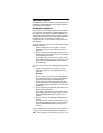Netfinity Manager 109
gram command-line parameters. The Netfinity Manager
installation program supports the following command-line
parameters:
/R:
drive+path+filename
Specifies the drive, path, and file name of the response
file. See the NETFBASE.RSP file (located in the direc-
tory in which Netfinity Manager was installed) for an
example of a response file with comments on the
included parameters.
/S:
drive+path
Specifies the drive and path to install
from
. This is the
directory to which the files were copied.
/T:
drive
Specifies the drive to install
to
. Default is the current
startup drive.
/TU:
drive+path
Specifies the drive and path of the CONFIG.SYS file to
update. The default is to change the CONFIG.SYS in
the root directory of the drive specified in the /T param-
eter (or the startup drive). This parameter is ignored if
the
ChangeConfig
parameter in the response file is
FALSE.
For example, the line:
NETFINST /R:NETFBASE.RSP /S:Y:\NETFIN
/T:C /TU:D:\
will install Netfinity Manager, using the options in the
response file NETFBASE.RSP, from the directory
Y:\NETFIN, to drive C: (the directory to which the files
are installed is taken from the response file), and will
modify the CONFIG.SYS file in the D:\ directory.
Note: For information on how to use a CID-enabled soft-
ware distribution manager, refer to the publications
provided with the individual CID-enabled product.
Customized installation
For security reasons, not all users might need to have
access to all services. User access can be restricted by cre-
ating a customized installation that will prevent some ser-
vices from being installed.
To create a customized installation, the INSTALL.INI file
must be edited. For example, when creating a customized
Netfinity Manager for Windows 95 or NT installation, edit the
INSTALL.INI file that is found on Netfinity Manager directory.
The INSTALL.INI file has three sections, separated by the
line
[==]
The first section contains the installation configuration that
can be selected during installation. There can be no more
than eight choices. Each choice takes up two lines. The
first line is the text that is displayed next to the installation
configuration radio button. The second line is a list of the
options in the third section that will be installed when this
choice is selected for installation.


















